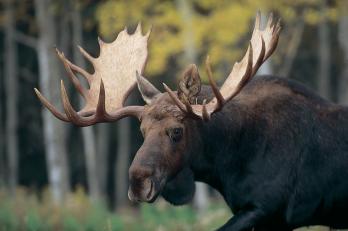
The deer family, Cervidae, consists of approximately thirty-five species of long-legged browsers with deciduous bony antlers on the frontal bones of the skull of males, and glands on the face before the eye. They occur on all continents except for Australia and Africa, south of the Sahara. They are usually found in woodlands or the edges of forests. Saskatchewan has five species of deer. Several of the species have burgeoning populations, particularly the white-tailed deer, following the killing off of their natural predators. Others have reduced populations owing to the contraction of their former habitats with settlement and opening of the boreal forest. Hunting is allowed of those species with healthy populations.
The largest, with a 1.8 m shoulder height for a large male, is the moose (Alces alces). This marsh-feeding deer with broad, spatulate antlers is found in wooded areas of the boreal plains and in the boreal forest, including the boreal remnants in the Moose Mountain and Cypress Hills areas. The other large species, the elk or wapiti (Cervus elaphus), with branching antlers, is mostly found in the Boreal Plains Ecozone of the centre of the province, with small populations in some wooded areas in the prairies, such as Moose Mountain and the Cypress Hills. Unlike moose, in which the male stays with and defends a cow while she remains in breeding condition, the male elk gathers a harem of females in the fall, which he defends from rival males.
The white-tailed deer (Odocoileus virginianus), a small, lightly built deer, is the most common and widespread species, found from the southern boundary to the Churchill River. While the white-tailed deer is found throughout temperate North America, except for the southwestern deserts, the mule deer (O. hemionus) is a western deer. Mule deer are more abundant in the southwest, although they may be found in other areas of the grasslands and parklands. The males of both species have branching antlers and do not form harems. Members of the genus Rangifer are the only deer in which females develop antlers; these are smaller than those of the males. The caribou (R. tarandus) are midway in size between the smaller deer and the elk. During the fall breeding season males gather a number of females, which they defend against other males. The barren-ground populations form large herds which migrate over their sparsely vegetated feeding grounds in the northern boreal forest and Taiga Shield regions of the extreme north of the province. The woodlands population is found in small, static groups in the boreal forest, where they feed on lichens and flowering plants.
Diane Secoy